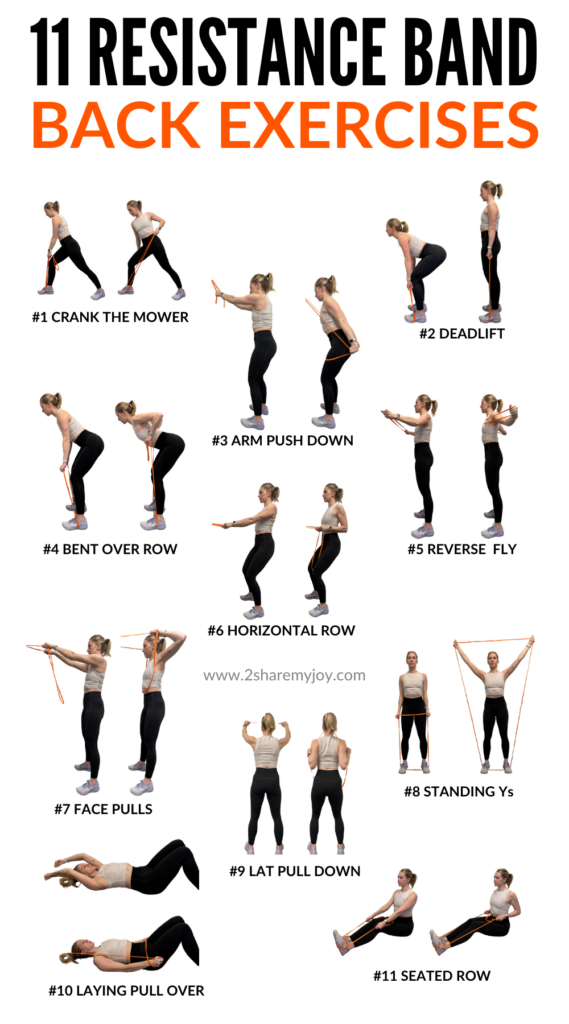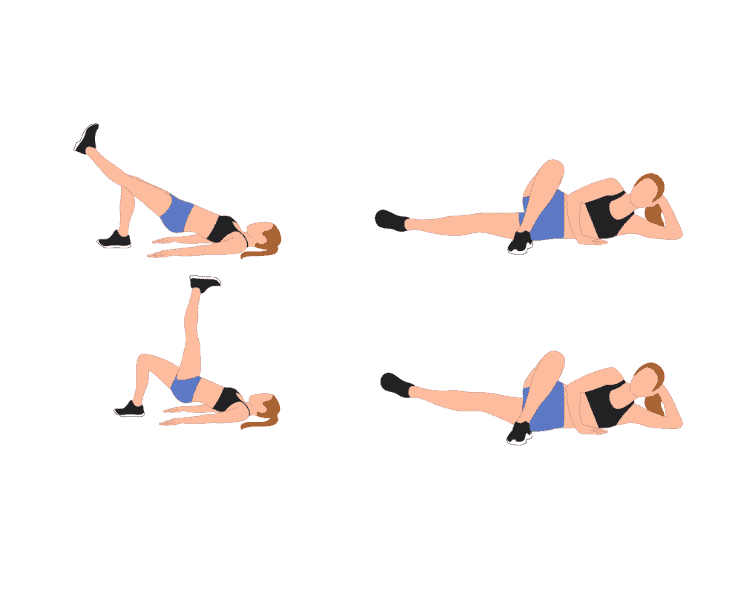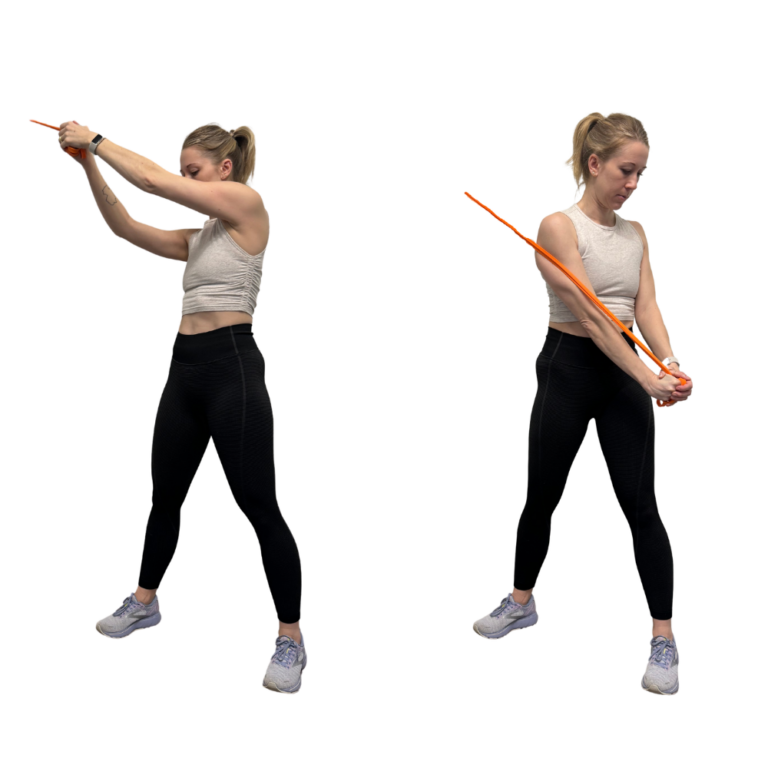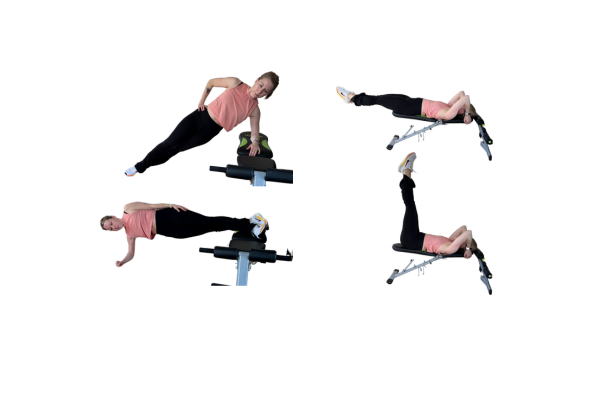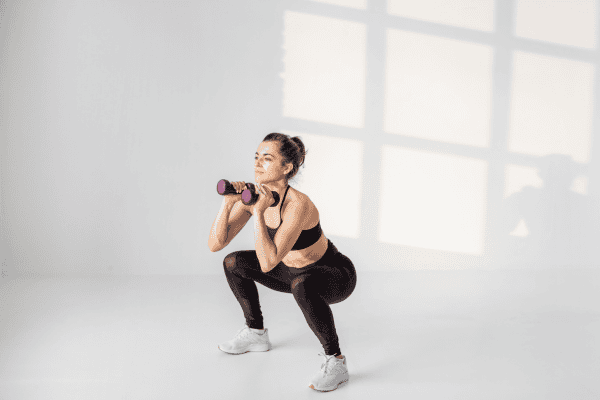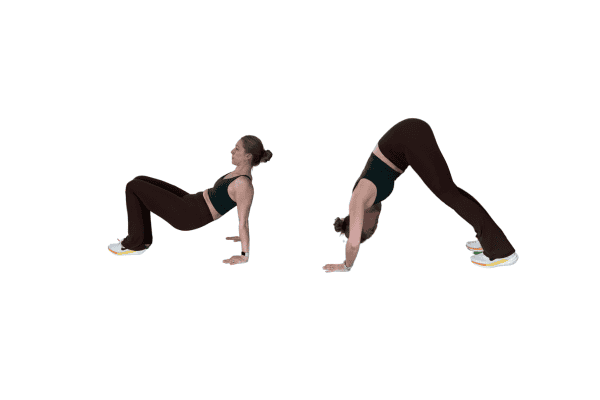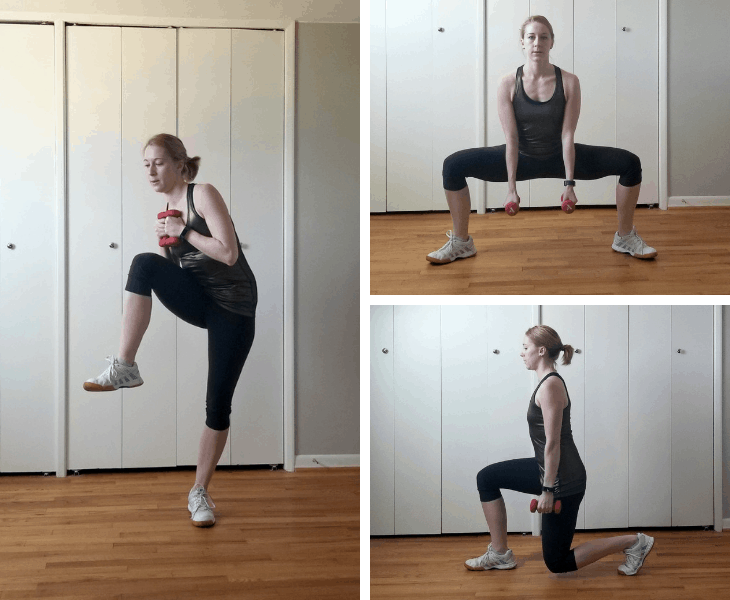11 Resistance Band Back Exercises
Here are the best resistance band back exercises that you can do at home with or with no anchor needed.
Resistance band exercises can build lots of strength, endurance, balance, and stability. And all this for a low price and in the comfort of your home!
Can you train your back with resistance bands?
Absolutely, training your back with resistance bands is not only possible but can be highly effective and ahs many benefits. Resistance bands provide a versatile and convenient way to target various muscle groups, including the muscles in your back.
Whether you’re a beginner looking to build strength or an experienced fitness enthusiast seeking a portable and efficient workout option, resistance bands can be a valuable addition to your training routine.
Resistance band training offers a joint-friendly alternative when compared to free weights. What sets resistance bands apart is their ability to maintain constant tension throughout an exercise.
This consistent resistance challenges your muscles during both the concentric (muscle shortening) and eccentric (muscle lengthening) phases, effectively stimulating muscle activation and growth.
As this meta-analysis demonstrated that training with elastic resistance provide strength gains similar to training with conventional resistance.
Moreover, incorporating resistance bands into your workout routine encourages enhanced stability and core strength, adding a functional dimension to your training. This integration of bands often demands increased stability and balance, resulting in a more effective engagement of your core muscles.
Consequently, your focus extends beyond targeting just the primary muscle group, encompassing stabilizing muscles and promoting overall functional strength.
Additionally, the benefits extend to the affordability and portability of resistance bands, making them a practical choice for individuals at any fitness level, be it beginners or advanced enthusiasts. This versatility allows for a seamless integration into your fitness regimen, ensuring a well-rounded and effective workout experience.
More Resistance Band Workouts:
- Resistance Band Leg Workout
- Resistance Band Glute Workout
- Resistance Band Core Workout
- Resistance Band Arm Workout
Types of resistance bands
There are different types of resistance bands and various accessories available for their use.
Loop resistance bands are the larger loops. Then you have the tubes that come with handles, and mini bands that are also a loop but much shorter.
All bands come in different difficulty levels or strengths. I prefer using the normal-sized loop bands because you can use them more versatilely, and you can always double-wrap them to make them mini.
Tube bands are also great; however, finding quality bands that last long can be a bit challenging. Common complaints include the tube (or band) slipping out of the handle.
Are resistance bands good for back pain?
Yes, resistance bands can be beneficial for individuals experiencing back pain. The controlled and adaptable nature of resistance band exercises allows for a targeted approach to strengthening the muscles supporting the spine.
By engaging in specific exercises that focus on the back muscles, individuals can improve overall muscle endurance and stability in the lumbar region.
Resistance bands offer a low-impact option for those with back pain, as they provide a gentler form of resistance compared to heavy weights. The gradual progression in resistance levels allows individuals to start with minimal strain and gradually increase intensity as their strength improves.
Individuals experiencing back pain often find relief by strengthening their abdominal muscles. This is where resistance bands prove to be highly effective for back pain management.
The versatility of resistance bands allows for a comprehensive activation of the entire core, even during exercises primarily targeting other muscles.
However, please consult your doctor before starting any exercises if you experience back pain.
How do you lose back fat with resistance band back exercises?
It is a common myth that you can train an area of your body and think this is where you will lose fat.
Unfortunately, you can’t choose the area of fat loss on your body. You would have to lose fat altogether, and everyone starts fat loss in a different body location.
So, to lose back fat, you would need to increase your calorie output or reduce calorie input. However, these resistance back exercises can help build your back muscles, so when you lose fat, your back looks toned and strong.
Read more: What almost everyone gets wrong about weight loss
Will these resistance band back exercises help with bad posture from sitting on a desk all day?
To improve upper back posture, it is important to strengthen muscles that weaken from long periods of sitting, such as the rhomboid and lower trapezius muscles.
Exercises like the Superman and Y raises are great to combat these.
However, it is also important to stretch the muscles that tend to tense up from long sitting, which are the upper trapezius and also the front of the chest muscles. You can do stretches or use a massage tool to relax these muscles.
5 Best Resistance Band Back Exercises with Anchor
#1 Lat Pull Down
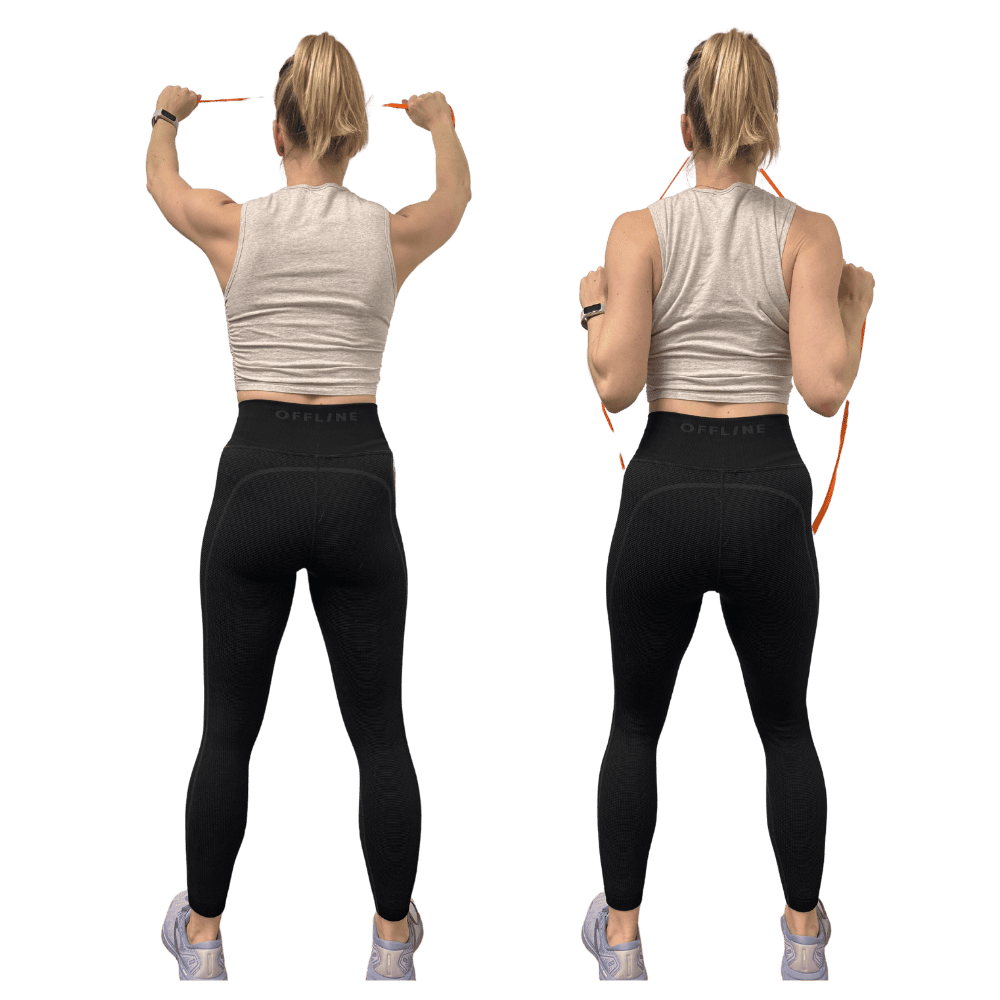
- Attach the resistance band to a sturdy overhead anchor point. This could be a pull-up bar, door frame anchor, or any secure point above head height.
- Stand facing the anchor point and grab the resistance band with an overhand grip, hands slightly wider than shoulder-width apart.
- Position your feet hip-width apart for stability. Stand with a straight posture, shoulders pulled back, and core engaged. Keep a slight bend in your knees.
- Initiate the movement by pulling the band down towards your chest. Focus on engaging your lat muscles (the muscles in your upper back). Keep your elbows pointing downward throughout the movement.
- As you pull the band down, squeeze your shoulder blades together. This will engage your back muscles and ensure you’re targeting the right areas.
- Continue pulling the band down until your hands are close to your chest and your elbows are pointing towards the floor. At this point, your back muscles should be fully contracted.
- Slowly return to the starting position by allowing your arms to extend overhead in a controlled manner. Resist the urge to let the band snap back.
#2 Laying Pull Over
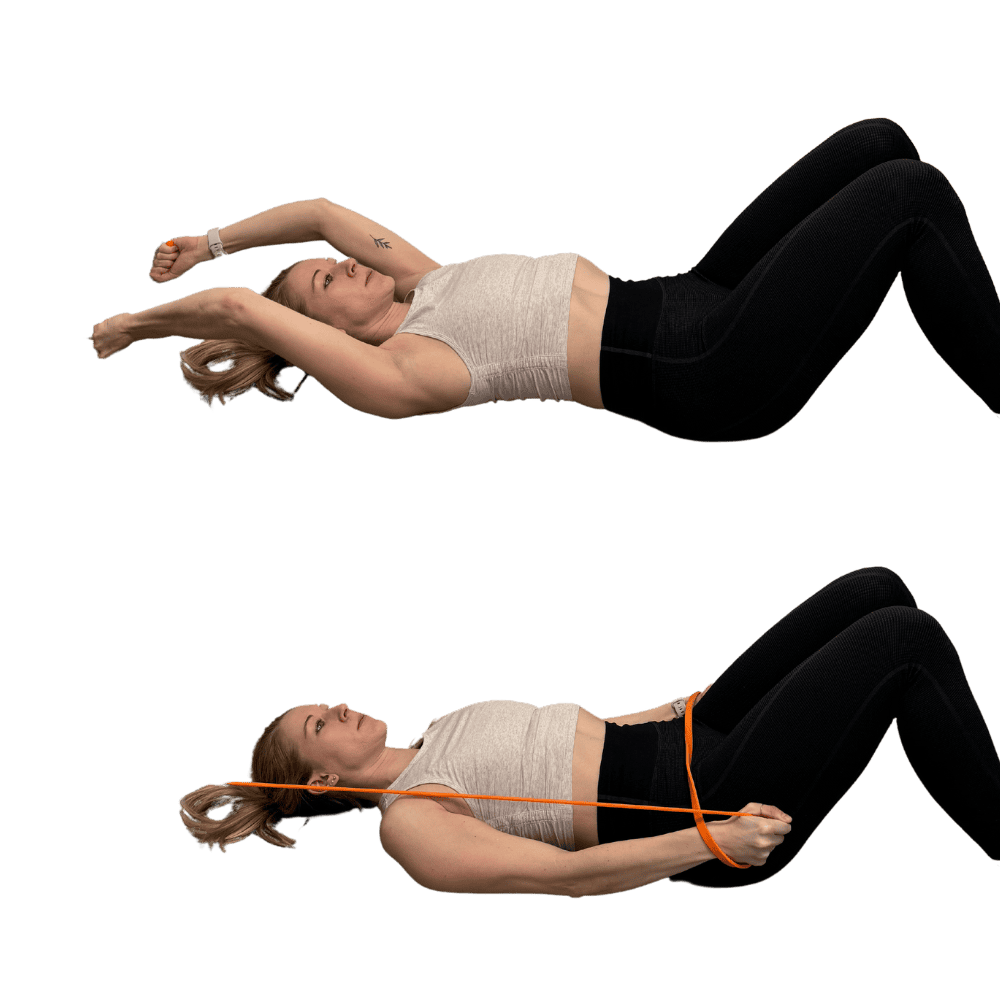
- Anchor the resistance band to a secure point, such as a sturdy post or a horizontal bar at ground level.
- Lie down on your back on a mat or bench. Ensure that your head and upper back are comfortably supported.
- Extend your arms overhead, keeping a slight bend in your elbows. Your hands should be positioned slightly wider than shoulder-width apart. Grab your resistance band and make sure there is some tension.
- Plant your feet flat on the ground, hip-width apart, for stability. Engage your core to maintain a neutral spine.
- Pull your arms over your body towards the floor. Keep a slight bend in your elbows throughout the exercise.
- Feel the stretch in your chest and lats as your arms descend towards the floor. This is the bottom position of the pull-over.
- Engage your chest, back, and triceps to pull the resistance band back up to the starting position. Focus on using the muscles in your upper body rather than relying solely on your arms.
- At the top of the movement, your arms should be extended overhead, and you should feel a contraction in your chest and lats.
#3 Standing Horizontal Row
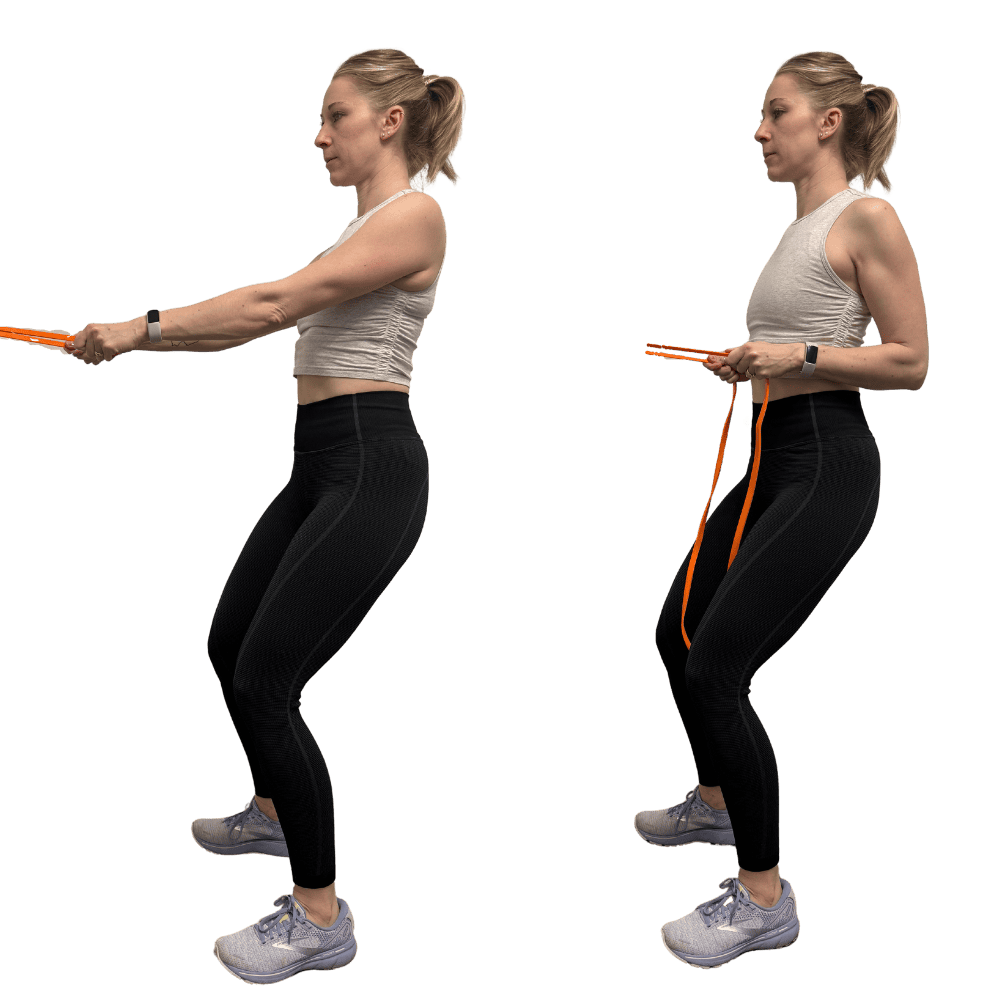
- Securely anchor the resistance band to a fixed point at chest height. This could be a sturdy post, door frame anchor, or any stable structure. Stand facing the anchor point where the resistance band is attached. Your feet should be hip-width apart for stability.
- Hold the resistance band with an overhand grip, palms facing down. Your hands should be positioned slightly wider than shoulder-width apart.
- Lean slightly backward, keeping your back straight and chest lifted. Engage your core muscles to maintain a stable posture throughout the exercise.
- Begin with your arms extended in front of you, pulling the resistance band taut. This is your starting position.
- Initiate the rowing movement by pulling your hands towards your chest, keeping your elbows close to your body. Focus on squeezing your shoulder blades together as you pull.
- At the top of the movement, your hands should be near your chest, and your shoulder blades should be fully contracted. Feel the engagement in your upper back muscles.
- Slowly extend your arms back to the starting position, maintaining tension on the resistance band. Resist the urge to let the band snap back.
#4 Standing Face Pulls
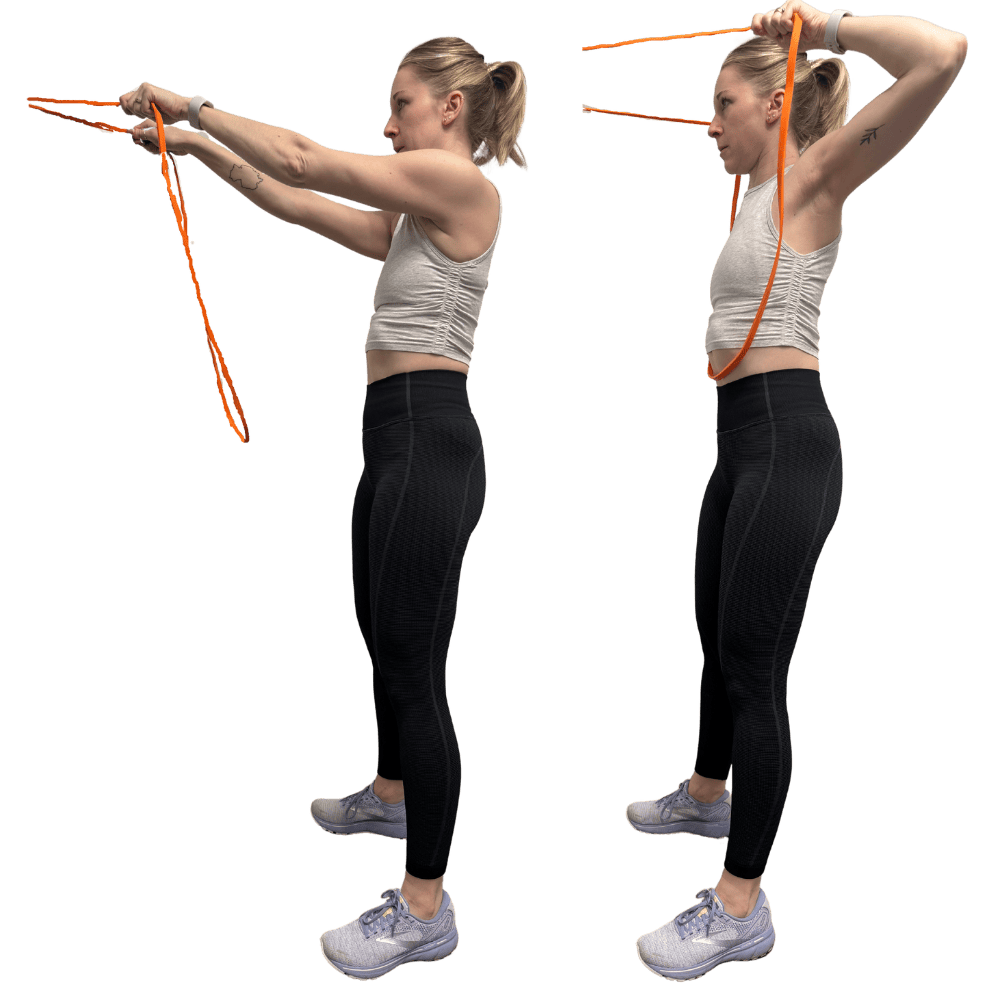
- Securely anchor the resistance band to a fixed point at approximately face height. This could be a sturdy post, door frame anchor, or any stable structure.
- Stand facing the anchor point where the resistance band is attached. Your feet should be hip-width apart for stability.
- Hold the resistance band with both hands, using an overhand grip. Your hands should be positioned slightly wider than shoulder-width apart.
- Step back to create tension in the resistance band. Stand with a straight posture, shoulders pulled back, and core engaged.
- Begin with your arms extended in front of you, pulling the resistance band taut. This is your starting position.
- Initiate the movement by pulling the band towards your face. Focus on bringing your hands towards the sides of your face, keeping your elbows high.
- As you pull the band, squeeze your shoulder blades together to engage the muscles in your upper back. Emphasize the contraction in your rear deltoids and upper traps.
- At the end of the movement, your hands should be near the sides of your face, and your upper back muscles should be fully contracted.
- Slowly extend your arms back to the starting position, maintaining tension on the resistance band. Avoid letting the band snap back quickly.
#5 Straight Arm Push Down
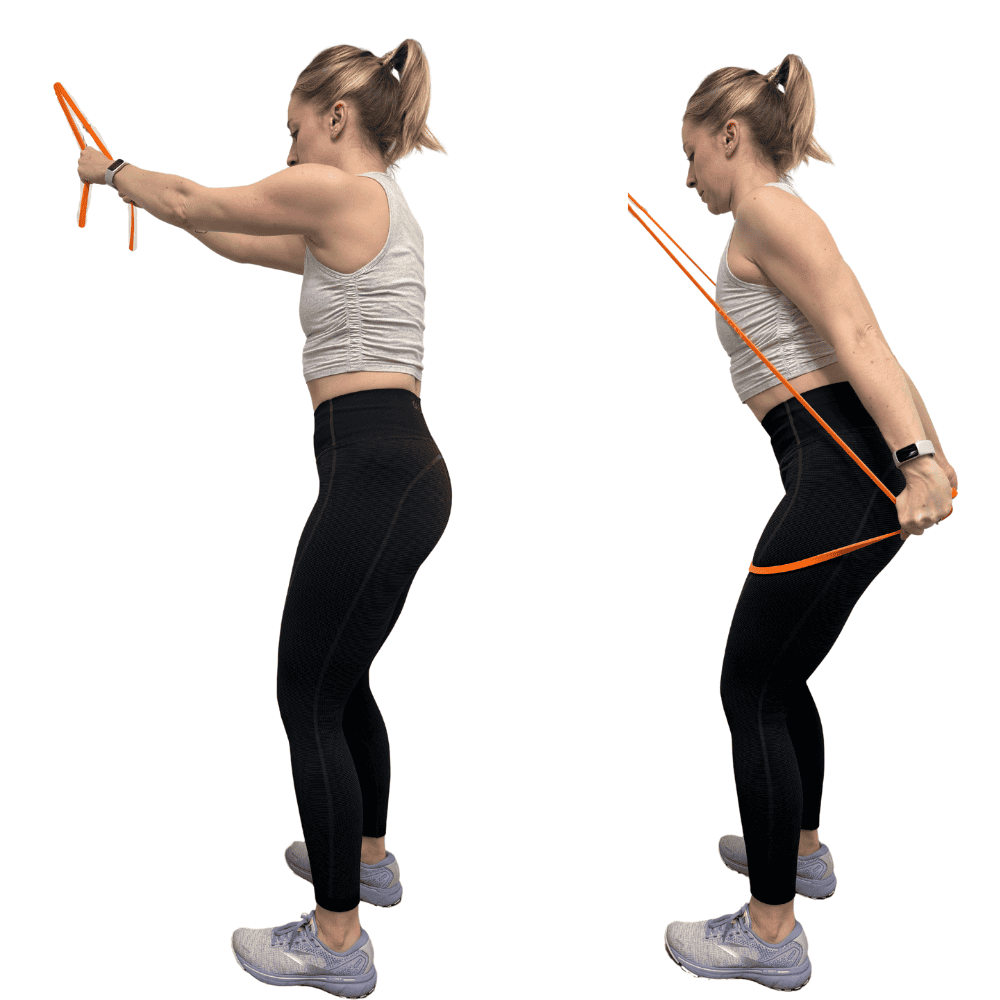
- Securely anchor the resistance band to a fixed point above head height. This could be a pull-up bar, door frame anchor, or any stable structure.
- Stand facing the anchor point where the resistance band is attached. Your feet should be hip-width apart for stability.
- Hold the resistance band with both hands, using an overhand grip. Your hands should be positioned shoulder-width apart.
- Step back to create tension in the resistance band. Stand with a straight posture, shoulders pulled back, and core engaged. Your arms should be fully extended in front of you
- Begin with your arms extended downward, pulling the resistance band taut. This is your starting position.
- Initiate the movement by pushing the band downward by straightening your arms. Keep your elbows locked and close to your body throughout the movement.
- Focus on engaging your triceps as you push the band down. Contract your triceps at the end of the movement.
- At the bottom of the movement, your arms should be fully extended downward, and you should feel a strong contraction in your triceps.
- Slowly raise your arms back to the starting position, maintaining tension on the resistance band. Avoid letting the band snap back quickly.
6 Best Resistance Band Back Exercises NO Anchor
#1 Reverse Fly
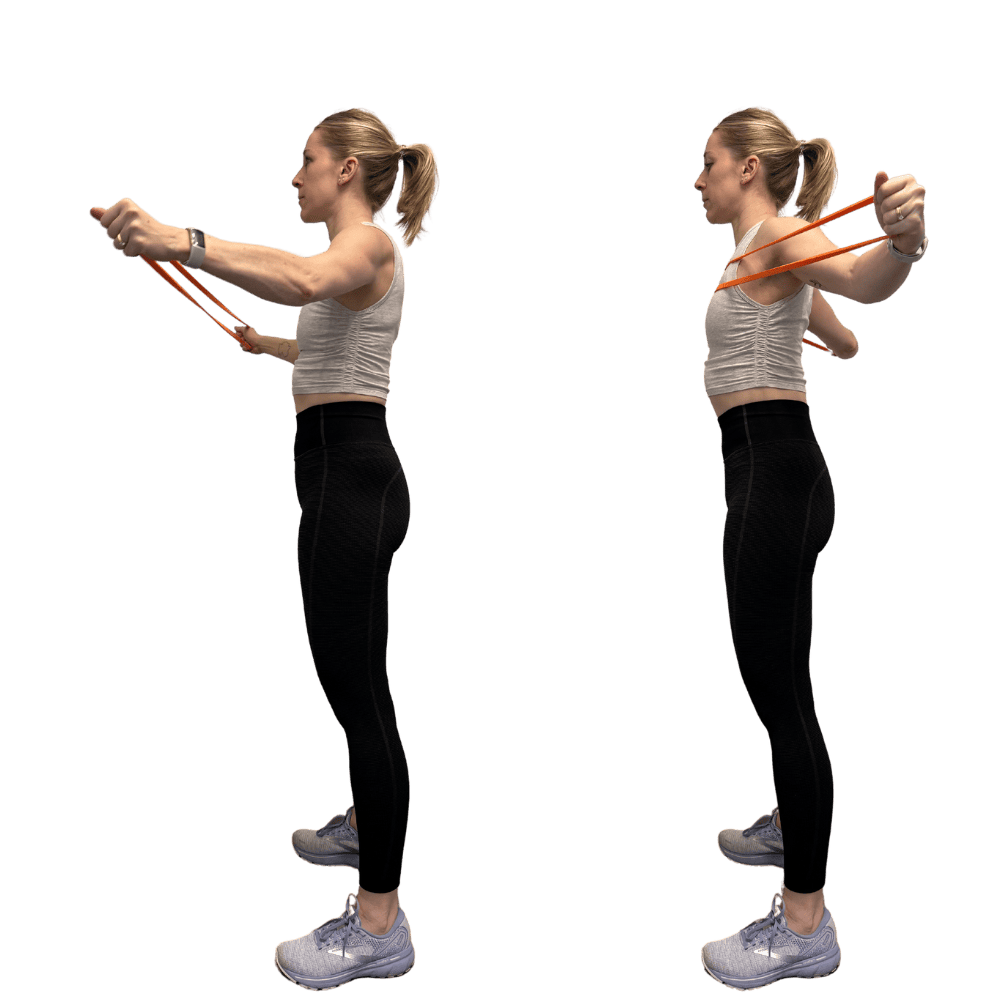
- Stand with your feet hip-width apart, placing both feet on the middle of the resistance band to secure it to the ground. Make sure the band is under the arches of your feet.
- Hold one end of the resistance band in each hand with an overhand grip. Your palms should be facing each other, and your hands should be in line with your shoulders.
- Bend your knees slightly and hinge forward at your hips to bring your torso close to parallel with the ground. Maintain a straight back and engage your core for stability.
- Begin with your arms hanging straight down in front of you, and there should be tension in the resistance band. This is your starting position.
- Initiate the movement by raising both arms out to the sides in a reverse fly motion. Focus on squeezing your shoulder blades together and lifting your arms to shoulder height.
- Keep a slight bend in your elbows throughout the movement to engage the rear deltoids and avoid unnecessary stress on your joints.
- At the top of the movement, your arms should be parallel to the ground, and your shoulder blades should be fully contracted. Feel the engagement in your upper back muscles.
- Slowly lower your arms back to the starting position, maintaining tension on the resistance band. Avoid letting the band snap back quickly.
#2 Bent Over Row
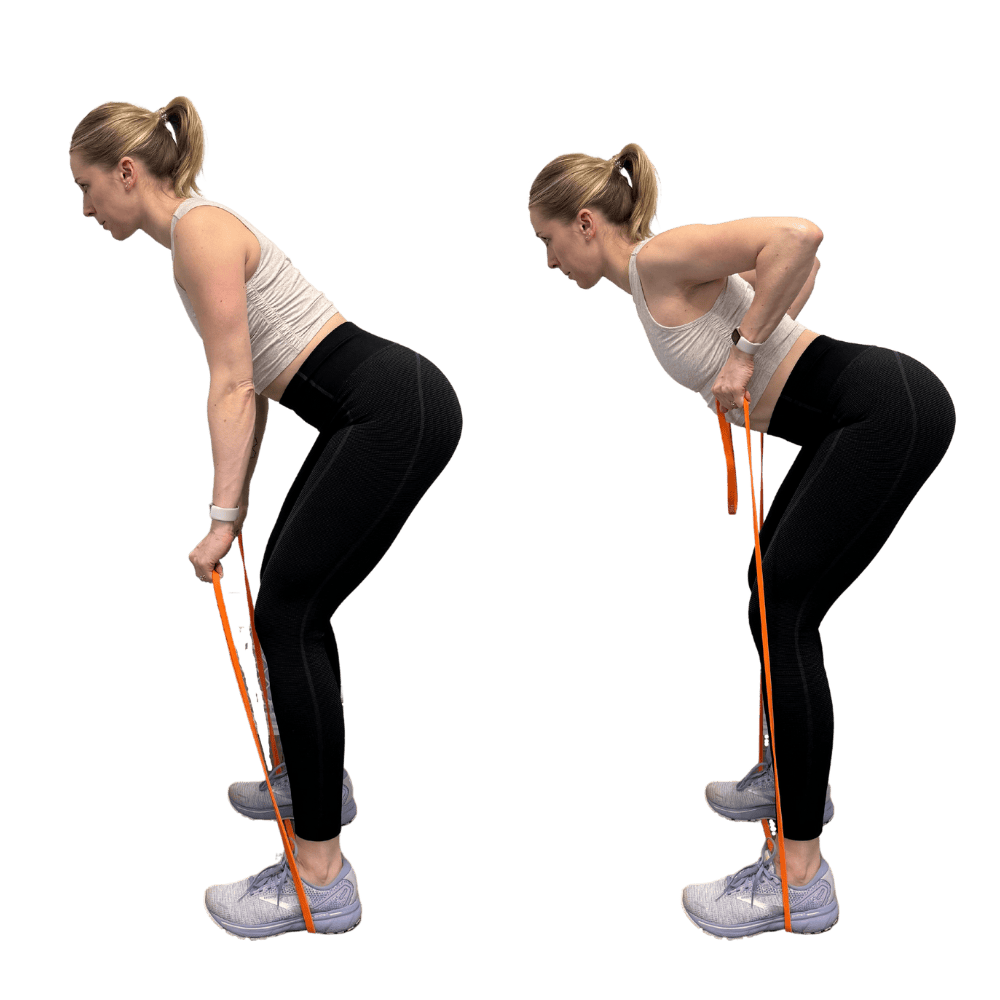
- Stand with your feet hip-width apart and place both feet on the middle of the resistance band. Ensure that the band is securely under the arches of your feet.
- Hold one end of the resistance band in each hand with an overhand grip. Your palms should be facing each other, and your hands should be in line with your shoulders.
- Bend your knees slightly and hinge forward at your hips, bringing your torso close to parallel with the ground. Maintain a straight back, engage your core for stability, and let your arms hang straight down in front of you.
- Begin with your arms fully extended toward the ground, and there should be tension in the resistance band. This is your starting position.
- Initiate the movement by pulling the band towards your lower chest, keeping your elbows close to your body. Focus on squeezing your shoulder blades together and lifting your hands toward your lower chest.
- Keep a slight bend in your elbows throughout the movement to engage the muscles in your upper back and avoid unnecessary stress on your joints.
- At the top of the movement, your hands should be close to your lower chest, and your shoulder blades should be fully contracted. Feel the engagement in your upper back muscles.
- Slowly lower your arms back to the starting position, maintaining tension on the resistance band. Avoid letting the band snap back quickly.
#3 Deadlift
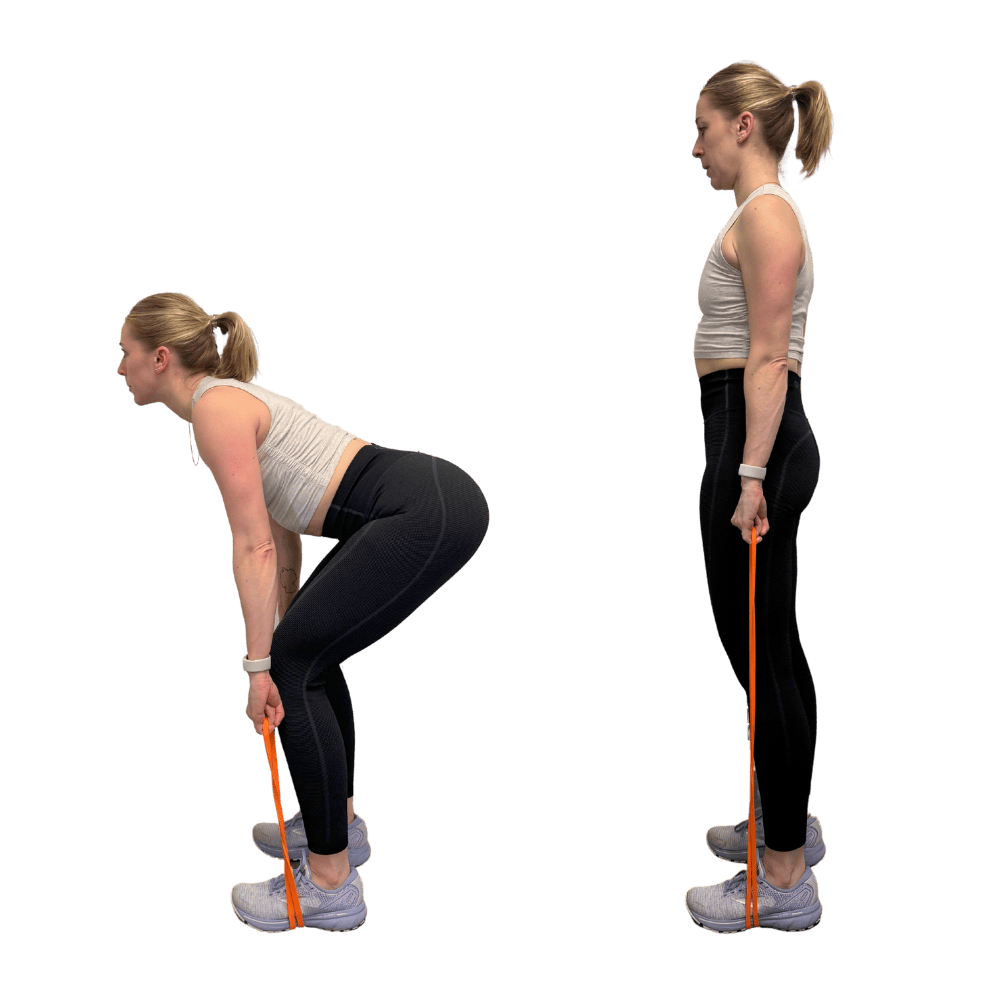
- Stand with your feet hip-width apart and place both feet on the middle of the resistance band. Ensure that the band is securely under the arches of your feet.
- Hold one end of the resistance band in each hand with an overhand grip. Your palms should be facing your body, and your hands should be aligned with your shoulders.
- Begin with your arms fully extended toward the ground, and there should be tension in the resistance band. Keep a slight bend in your knees.
- Initiate the movement by hinging at your hips and pushing your hips backward. Maintain a straight back and allow your torso to lean forward as your hips move back.
- As you hinge at your hips, bend your knees slightly to lower your torso. Keep your back straight, and your chest lifted throughout the movement.
- As you reach the bottom of the movement, engage your glutes and hamstrings. Your weight should be in your heels, and your back should remain straight.
- Initiate the upward movement by driving through your heels, straightening your hips, and bringing your torso back to an upright position. Keep the resistance band close to your body throughout the movement.
- At the top of the movement, stand tall with your hips fully extended, and your shoulders pulled back. Squeeze your glutes at the top to maximize the engagement of your posterior chain.
- Lower your torso back down by hinging at your hips and bending your knees, maintaining control throughout the descent.
#4 Crank the Mower
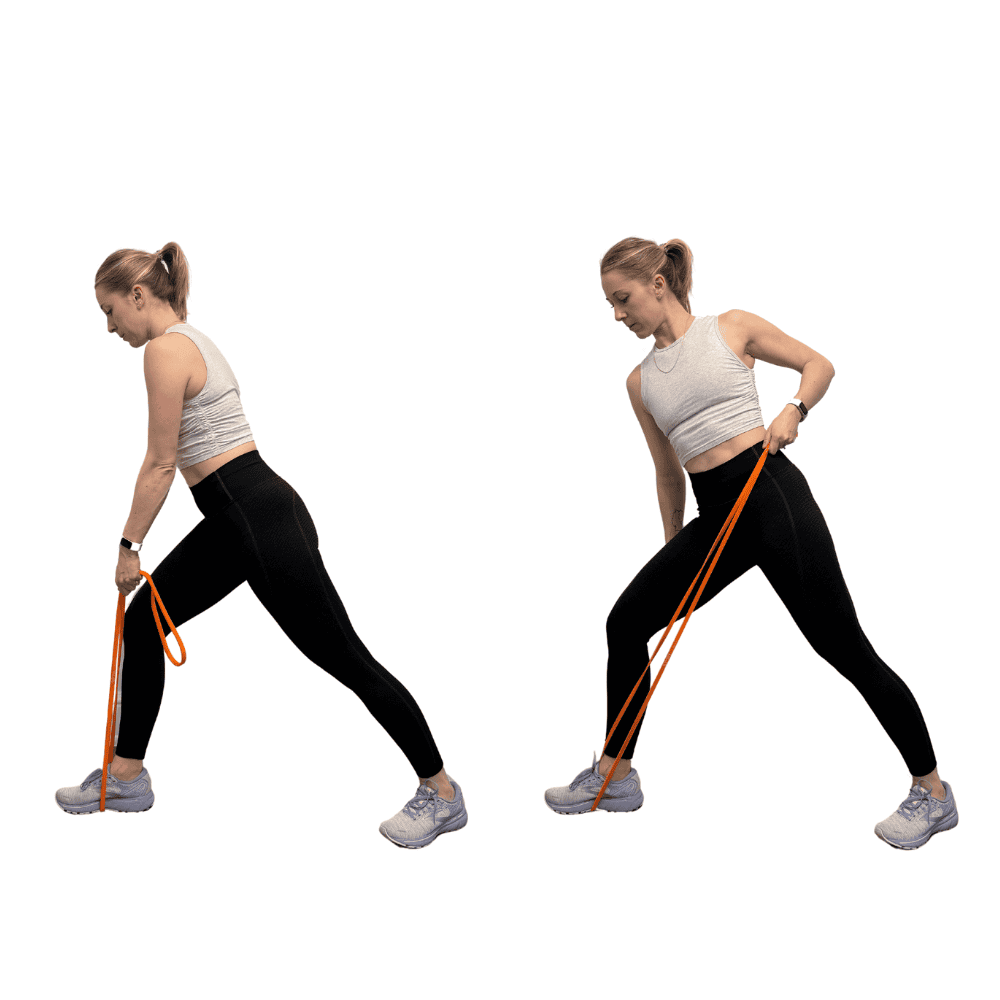
- Stand in split stance and place the front foot on the middle of the resistance band. Ensure that the band is securely under the arch of your foot.
- Hold the other end of the resistance band with the hand opposite to the foot that’s on the band.
- Initiate the movement by pulling the resistance band upward and toward your hip, mimicking the motion of starting a lawnmower. Keep your elbow close to your body as you pull.
- As you pull, focus on squeezing your shoulder blade toward your spine. This engages the muscles in your upper back.
- At the top of the movement, your hand should be near your hip, and your upper back muscles should be fully contracted. Feel the engagement in your lats and rhomboids.
- Slowly lower your hand back down to the starting position, maintaining tension on the resistance band. Avoid letting the band snap back quickly.
#5 Standing Ys
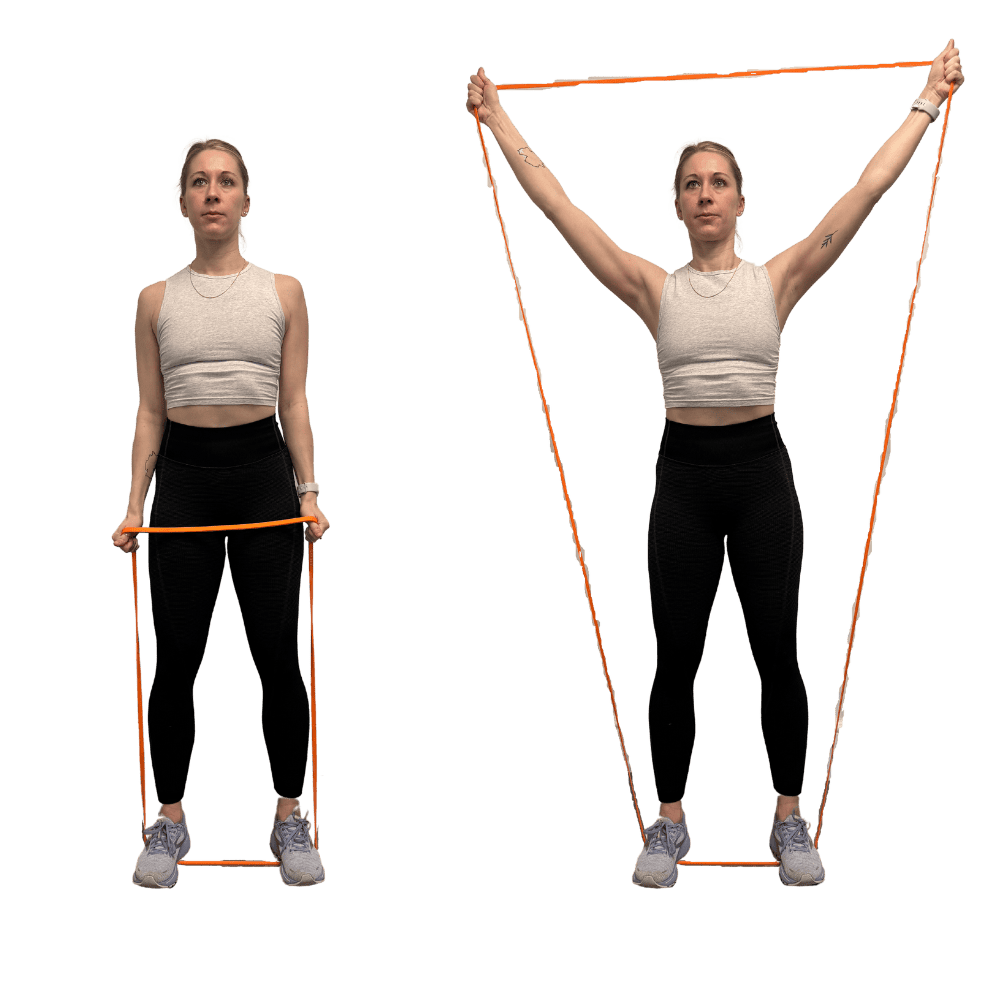
- Stand with your feet hip-width apart and place both feet on the middle of the resistance band. Ensure that the band is securely under the arches of your feet.
- Hold one end of the resistance band in each hand with an overhand grip. Your palms should be facing each other, and your hands should be in line with your shoulders.
- Begin with your arms hanging straight down in front of you, and there should be tension in the resistance band. Your hands should be close together in front of your thighs.
- Initiate the movement by raising both arms diagonally in front of you, forming a Y shape with your body. Keep your arms straight throughout the movement.
- Focus on engaging your shoulder muscles, particularly the deltoids, as you lift your arms. Keep a slight bend in your elbows to avoid locking your joints.
- At the top of the movement, your arms should be extended overhead, forming a Y shape with your body. Your hands should be shoulder-width apart, and your shoulders should be fully engaged.
- Lower your arms back down to the starting position in a controlled manner. Maintain tension on the resistance band throughout the descent.
#6 Seated Row
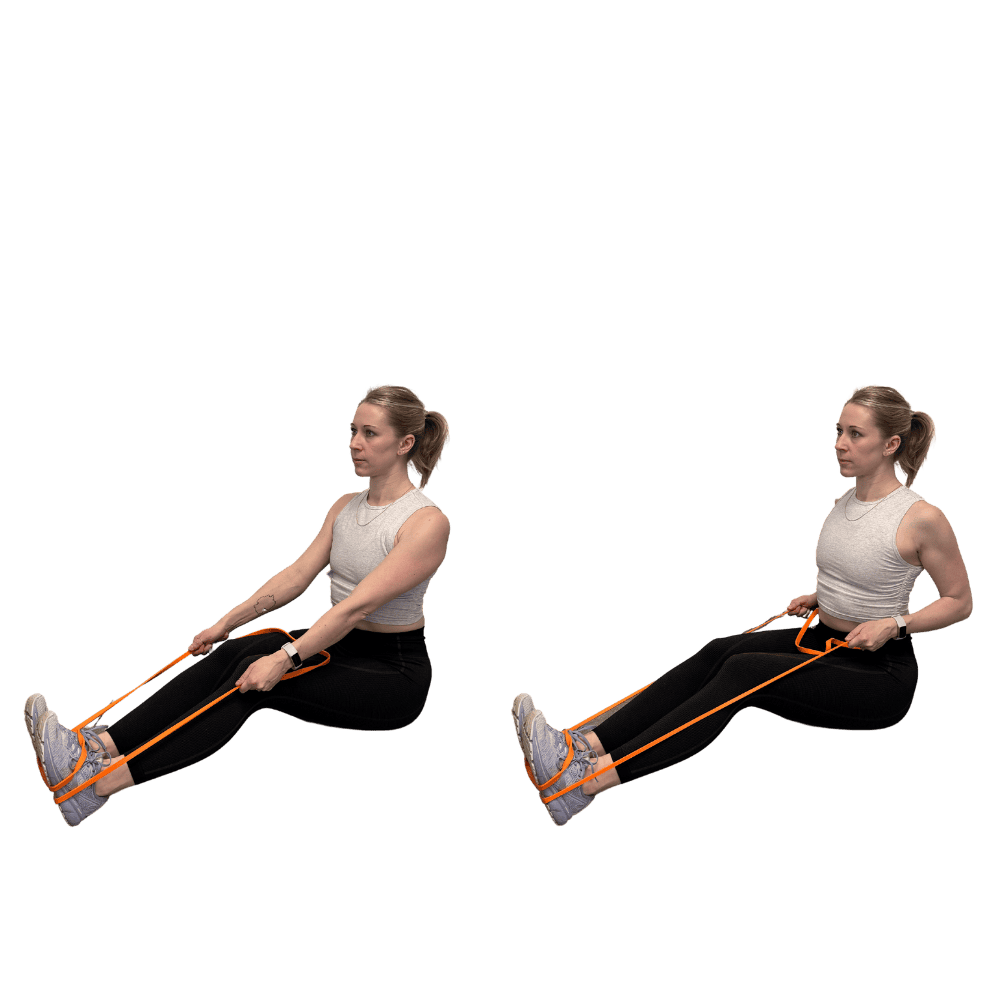
- Sit on the floor with your legs extended in front of you. Keep your back straight, chest lifted, and knees slightly bent.
- Place the resistance band around the soles of your feet and hold one end of the band in each hand. Ensure that the band is securely wrapped around your feet.
- Hold the ends of the resistance band with an overhand grip. Your palms should be facing each other.
- Begin with your arms fully extended in front of you, pulling the resistance band taut. This is your starting position.
- Initiate the rowing movement by pulling the band towards your lower chest. Keep your elbows close to your body and focus on squeezing your shoulder blades together as you row.
- At the end of the movement, your hands should be close to your lower chest, and your shoulder blades should be fully contracted. Feel the engagement in your upper back muscles.
- Slowly extend your arms back to the starting position, maintaining tension on the resistance band. Avoid letting the band snap back quickly.
